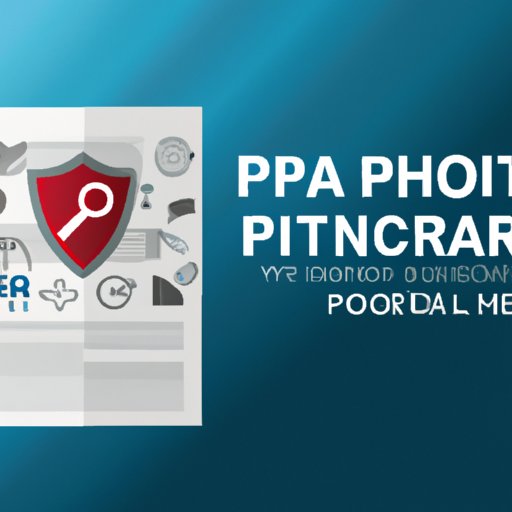Introduction
Protected health information (PHI) is any information related to an individual’s physical or mental health that is used or collected by a healthcare provider. This includes information such as medical records, laboratory results, diagnoses, treatment plans, and insurance claims. The purpose of this article is to discuss the definition of PHI, the federal laws that govern PHI, how PHI is used and protected, the role of the HIPAA Privacy Rule in protecting PHI, examples of PHI, and best practices for protecting PHI.

Federal Laws that Govern PHI
The Health Insurance Portability and Accountability Act (HIPAA) Privacy Rule is the primary law that governs PHI. The HIPAA Privacy Rule was established in 2003 to protect the privacy of individuals’ health information. The rule applies to all healthcare providers, health plans, and other entities that handle PHI. In addition, the HITECH Act of 2009 amended the HIPAA Privacy Rule to include additional requirements for protecting PHI.

How PHI is Used and Protected
Healthcare providers, such as doctors and nurses, use PHI to diagnose and treat patients. They also use PHI to provide information to other healthcare providers, such as specialists, who are involved in the patient’s care. Other entities, such as insurance companies and government agencies, may also use PHI in order to process claims and provide coverage. Healthcare providers and other entities must take steps to protect PHI from unauthorized access and disclosure.
One way that PHI is protected is through the use of technology. Technology solutions, such as encryption, can be used to ensure that only authorized individuals have access to PHI. Other technology solutions, such as secure messaging systems, can be used to securely transmit PHI between healthcare providers and other entities.

The Role of the HIPAA Privacy Rule in Protecting PHI
The HIPAA Privacy Rule protects PHI by setting standards for how healthcare providers and other entities must use, store, and disclose PHI. Under the HIPAA Privacy Rule, healthcare providers and other entities must take steps to protect PHI from unauthorized access and disclosure. Examples of these steps include implementing administrative, technical, and physical safeguards; using encryption; and providing training to staff on how to protect PHI.
The HIPAA Privacy Rule also outlines what types of information are considered PHI. According to the U.S. Department of Health and Human Services, PHI includes “any information about health status, provision of health care, or payment for health care that is created or collected by a covered entity or business associate and can be linked to a specific individual.” This includes information such as medical records, laboratory results, diagnoses, treatment plans, and insurance claims.
Examples of PHI
There are several types of information that fall under the definition of PHI. These include demographic information, such as name, address, and date of birth; medical information, such as diagnoses, treatments, and medications; financial information, such as insurance claims and payment information; and genetic information, such as family history and genetic test results.
PHI can be used for a variety of purposes, including diagnosis and treatment, billing and payment, research, public health activities, and communication with other healthcare providers. For example, PHI can be used to create a patient’s medical record, communicate with other healthcare providers, process insurance claims, and conduct clinical research.
Best Practices for Protecting PHI
One of the most important steps that healthcare providers and other entities can take to protect PHI is to implement administrative, technical, and physical safeguards. Administrative safeguards involve developing policies and procedures for handling PHI, such as limiting access to PHI and providing training to staff on how to protect PHI. Technical safeguards involve using technology, such as encryption and secure messaging systems, to protect PHI. Physical safeguards involve controlling physical access to PHI, such as storing PHI in locked filing cabinets.
In addition, healthcare providers and other entities should also consider using technology solutions to protect PHI. Technology solutions, such as encryption and secure messaging systems, can help ensure that PHI is not accessible to unauthorized individuals. Healthcare providers and other entities should also consider using data backup systems to ensure that PHI is not lost in the event of a system failure.
Conclusion
Protected health information (PHI) is any information related to an individual’s physical or mental health that is used or collected by a healthcare provider. Federal laws, such as the HIPAA Privacy Rule, govern how PHI is used and protected. Healthcare providers and other entities must take steps to protect PHI from unauthorized access and disclosure. Examples of PHI include medical records, laboratory results, diagnoses, treatment plans, and insurance claims. Finally, best practices for protecting PHI include implementing administrative, technical, and physical safeguards, using encryption and secure messaging systems, and using data backup systems.
(Note: Is this article not meeting your expectations? Do you have knowledge or insights to share? Unlock new opportunities and expand your reach by joining our authors team. Click Registration to join us and share your expertise with our readers.)
